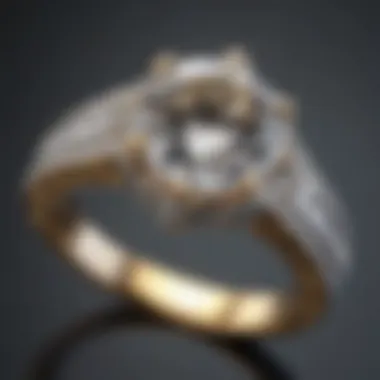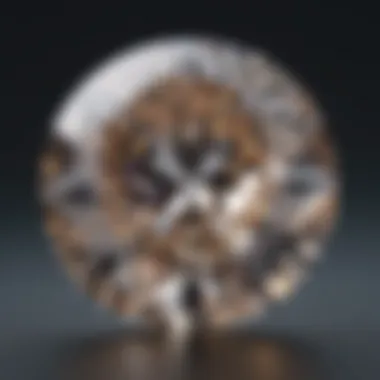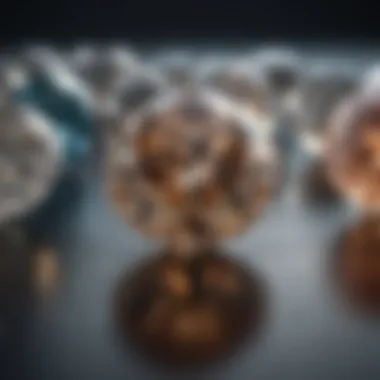Exploring the Solitaire Diamond Cut: A Comprehensive Guide


Intro
The solitaire diamond cut has secured its place as a timeless symbol of elegance and sophistication in the world of gemstones. As this guide unfolds, we will examine the nuances of the solitaire cut, from its historical roots to technical specifications. Understanding this cut is essential for anyone involved in the world of jewelry, whether as a buyer, designer, or collector. Each aspect of the solitaire diamond reflects not only beauty but also craftsmanship and emotion. This guide aims to deepen your appreciation and knowledge of the solitaire diamond cut.
Gemstone Overview
Description of the gemstone
A solitaire diamond is characterized by being set alone in a piece of jewelry, often in rings. This presentation maximizes its brilliance, allowing the stone to be the focal point. Typically, a high-quality solitaire is a round diamond, but the term also encompasses other shapes like princess or oval cuts, which are equally captivating. With its clear structure and reflective properties, the solitaire shines with exceptional luminosity, making it a preferred choice for many.
Physical properties
The physical properties of a high-quality diamond include:
- Carat Weight: Refers to the weight of the diamond. Commonly, larger carats increase visual impact, though smaller stones can be just as striking depending on quality.
- Clarity: Indicates the presence of internal or external flaws. A higher clarity rating means a more perfect diamond.
- Color: Ranges from colorless to various shades, with colorless being the most desirable.
- Cut: Dictates how well the diamond reflects light. The ideal cut enhances the stone’s brilliance and fire.
The combination of these properties determines the value and desirability of a solitaire diamond.
"The artistry of a well-cut diamond lies in its ability to manipulate light, enhancing its visual appeal and emotional resonance."
Historical Context
The solitaire diamond cut has a storied history that dates back centuries. Originating in ancient cultures, diamonds were often viewed as talismans believed to possess mystical powers. In more recent history, during the engagement ring boom of the 20th century, the solitaire cut gained immense popularity, becoming synonymous with love and commitment.
As we progress further into the guide, we will unravel the different styles of solitaire cuts, examine their impacts on performance, and provide strategies for selecting the right diamond based on individual preferences. This comprehensive look will instill confidence in your ability to choose wisely and appreciate the captivating world of solitaire diamonds.
Intro to Solitaire Diamond Cuts
Understanding solitaire diamond cuts is essential for anyone interested in fine jewelry, particularly those who wish to purchase or design high-quality pieces. Solitaire diamonds represent a classic choice for many occasions, notably engagement rings. Knowing the intricacies of these diamonds enhances the appreciation of their beauty and significance.
The solitaire diamond is not just a gem; it is a symbol of commitment and timelessness. By grasping the nuances of solitaire diamond cuts, one can make informed decisions, whether selecting an engagement ring or acquiring a noteworthy addition to a collection. This discussion aims to clarify various aspects of solitaire diamonds, ensuring the reader becomes more knowledgeable about their options.
Definition of Solitaire Diamonds
A solitaire diamond is a single gemstone set in a piece of jewelry, commonly seen in rings. This design emphasizes the diamond itself, drawing attention to its brilliance and size. The term "solitaire" derives from the French word for "alone," highlighting the diamond's solitary nature.
Typically, these diamonds are chosen for their visual impact; the absence of other stones allows for a focus on cut, clarity, color, and carat weight. The cut quality often determines how well a diamond reflects light, contributing to its overall sparkle. Consequently, the selection of a solitaire diamond necessitates careful consideration of these factors.
Historical Background
Throughout history, solitaire diamonds have played a notable role in jewelry, particularly in the context of engagement. The tradition of using a single diamond can be linked to the late 19th century, a period where diamond mining exploded and these precious stones became more accessible.
The first recorded use of a diamond engagement ring occurred in 1477 when Archduke Maximilian of Austria presented a diamond ring to Mary of Burgundy. This moment marked the beginning of a trend that has continued to endure in contemporary culture. The solitaire diamond became synonymous with love, fidelity, and eternal commitment, encapsulating emotional significance. As styles and trends evolved, the solitaire remained a favored choice for its simple yet elegant design.
Understanding this historical context helps to appreciate the weight that solitaire diamonds carry in both aesthetic preference and emotional attachment. Their enduring presence in the jewelry market speaks to their lasting appeal.
Understanding Diamond Cuts
Understanding diamonds cuts is essential for appreciating the beauty and value of diamonds, especially solitaire diamonds. The cut defines how well the diamond interacts with light. It affects the diamond’s sparkle, brilliance, and overall aesthetic appeal. When one learns about diamond cuts, one begins to understand the criteria that make a diamond truly exceptional.
Every diamond cut carries its own characteristics that can enhance its visual appeal. This section focuses on the importance of cut quality and the key factors that influence diamond cutting.


Importance of Cut Quality
Cut quality is a crucial aspect that separates an extraordinary diamond from an average one. Quality of cut influences how light is refracted and reflected within a diamond. A well-cut diamond will show light returns in a stunning display of brilliance. This quality is measurable and impacts not only appearance but value as well. Buyers often prioritize cut quality since it affects the diamond's overall performance. Thus, understanding cut quality is paramount for any potential buyer.
A well-executed cut can elevate a diamond's appeal tremendously. Conversely, a poorly cut diamond can appear dull and lifeless, regardless of its size or color. Therefore, focusing on cut quality is essential in making an informed purchasing decision.
Key Factors in Diamond Cutting
Several elements play a role in determining the overall quality of a diamond’s cut. Among them are proportion, symmetry, and polish. Each factor contributes to the diamond’s performance in light and visual aesthetics. Understanding these aspects is crucial for anyone interested in selecting the right solitaire diamond.
Proportion
Proportion refers to the dimensions of the diamond, including table size, crown angle, and depth. Proper proportions allow for optimal light performance. A well-proportioned diamond reflects light effectively, causing it to sparkle dazzlingly. Buyers should pay attention to this factor, specifically how balanced these measurements are. An optimal balance can result in a diamond that captures light beautifully.
However, improper proportions may lead to light leakage, which diminishes the diamond's brilliance.
Symmetry
Symmetry denotes the alignment and shape of a diamond's facets. Excellent symmetry enhances the overall appearance and light reflection. A diamond with perfect symmetrical facets will look more appealing. This quality is also indicative of skilled craftsmanship in the cutting process. Many discerning collectors often prefer diamonds with high symmetry ratings.
In contrast, a diamond with poor symmetry may present noticeable visual flaws. Such imbalances can distract from its beauty. Buyers should always look for symmetry in their selections to ensure that the diamond is visually appealing and well made.
Polish
Polish refers to the smoothness of the diamond's surface. A properly polished diamond will display brilliance without distractions from scratches or blemishes. High-quality polish indicates that the diamond was crafted with care and precision. This factor is crucial in ensuring the diamond shines effectively under various lighting conditions.
Though polish has minimal impact on light performance compared to proportions and symmetry, it still plays a significant role for those seeking perfection.
Each of these elements—proportion, symmetry, and polish—contributes to the allure and quality of a solitaire diamond. Buyers should consider each aspect carefully to appreciate the intricacies in selecting a diamond accordingly.
Characteristics of the Solitaire Cut
Understanding the characteristics of solitaire cuts is crucial when selecting diamonds. These features directly influence both the aesthetics and perceived value of the gemstone. Focusing on specific types, light performance, and other factors helps to determine the best choice for personal preferences and high standards.
Types of Solitaire Cuts
Round Brilliant
The Round Brilliant cut is the most popular option in the realm of solitaire diamonds. It is designed to maximize brilliance, showcasing the diamond's sparkle through its precisely cut facets. The key characteristic of the Round Brilliant is its 58 facets, which work together to reflect and refract light beautifully. This cut is a beneficial choice for those who desire a traditional yet striking appearance.
One unique feature of the Round Brilliant is its ability to evoke a sense of fire and brilliance. However, its popularity also raises the prices compared to other cuts. This means that while a Round Brilliant offers unmatched luster, potential buyers may need to consider their budget carefully.
Princess
The Princess cut has gained notoriety in recent decades and is recognized for its modern appeal. This cut combines elegance and contemporary style, making it a favored selection for many. The key characteristic of the Princess is its sharp corners and a squared shape, which often resembles a square or rectangular form. This cut is popular due to its striking visual impact and versatility in settings.
Interestingly, the Princess cut can exhibit impressive light performance, particularly when well-crafted. Its unique feature allows it to hide inclusions effectively, which may appeal to buyers concerned about clarity. However, the required precision in cutting can sometimes lead to higher costs, reflecting the intricate craftsmanship necessary for high-quality pieces.
Emerald
The Emerald cut presents a different artistic perspective compared to the Round Brilliant and Princess. It is characterized by its rectangular shape and stepped facets, allowing for a more unique flash of light. The key attribute of the Emerald cut is its elegant appearance, which evokes a sense of sophistication. This style is often chosen for its classic look and has become a symbol of refinement.


One unique feature of the Emerald cut is its ability to highlight a diamond's clarity. This can emphasize the pure qualities of the gemstone, favoring higher clarity diamonds. However, the structure can make it less able to hide imperfections compared to the Round Brilliant. Therefore, potential buyers should consider clarity grading before selecting an Emerald cut as their preferred option.
Impact on Light Performance
Light performance is a fundamental aspect when it comes to diamond cuts. The way a diamond interacts with light directly impacts its visual appeal. Different cuts will perform differently based on their shape and facet arrangement.
- Brilliance: This term describes the amount of white light reflected back from the diamond. Round Brilliants tend to excel in this area, producing a captivating sparkle.
- Fire: Refers to the colored light that is dispersed within the diamond. The ideal cut can contribute significantly to this effect, with the Round Brilliant typically scoring high.
- Scintillation: It involves the flashes of light seen as the diamond moves. Each cut type contributes to this appearance uniquely, influencing the choice of the consumer.
Choosing the Right Solitaire Diamond
Choosing the right solitaire diamond is a critical step in the journey of selecting a piece of fine jewelry, especially for significant occasions like engagements or anniversaries. The beauty of a solitaire diamond does not merely lie in its inherent brilliance, but also in how its qualities resonate with personal significance. Factors such as carat weight, color, and clarity play a determining role in the final choice, directly linking to both aesthetics and value.
Not only does a well-chosen diamond reflect the unique taste and preferences of the wearer, but it also conveys heartfelt symbolism. Each parameter influences the overall perception and allure of the gem. Understanding these specific elements can enhance the purchasing experience, allowing buyers to make informed decisions.
Carat Weight Considerations
Carat weight is a fundamental metric in assessing the size of a diamond. It is commonly perceived that larger diamonds command more attention and admiration; however, an ideal carat weight is subjective and varies depending on personal preferences and budget constraints.
When selecting a solitaire diamond, one must consider:
- Personal Preference: Consider whether a larger diamond aligns with your style or if a smaller one might suit better.
- Budget: Higher carat weights significantly increase the price. Prioritize what you feel comfortable spending.
- Visual Impact: A diamond's appearance is also dependent on its cut and setting. A smaller well-cut diamond may appear more brilliant than a larger, poorly cut one.
In practical terms, it is advisable to try different sizes to see what appeals most. The right carat weight enhances the beauty of the diamond while ensuring that the wearer feels confident and satisfied with their choice.
Color and Clarity Grades
The color and clarity of a diamond are crucial aspects that can significantly affect its aesthetic appeal and market value. Understanding these grades can demystify the selection process, allowing for a more tailored approach.
Color: Diamonds range from colorless to shades of yellow and brown. The GIA grades colors from D (colorless) to Z (light yellow). Choosing a color grade should reflect personal taste as well as the metal setting used. For example, a white gold or platinum setting can enhance the brilliance of a more colorless diamond.
Clarity: This refers to the presence of imperfections or inclusions in a diamond. Graded from Flawless (no inclusions visible under 10x magnification) to Included (inclusions visible to the naked eye), clarity impacts both beauty and durability. Ideally, choosing a diamond with high clarity ensures that flaws do not detract from its sparkle.
Ultimately, recognizing how color and clarity affect a diamond's look and value enables buyers to choose a piece that not only meets technical standards but also holds sentimental value. By factoring these two characteristics into the decision-making process, one can secure a solitaire diamond that resonates with personal significance.
The Significance of Solitaire Diamonds in Jewelry
Solitaire diamonds hold a unique place in the realm of fine jewelry. Their design simplicity contrasts with the exquisite craftsmanship behind them. This section highlights the importance of solitaire diamonds, seeing them not just as accessories but as symbols of personal significance and tradition.
One of the defining characteristics of solitaire diamonds is their ability to convey deep emotional messages. They often represent milestones such as engagements, anniversaries, or personal achievements. The singular nature of a solitaire diamond emphasizes the exclusivity of the occasion it marks. As an enduring token of love or commitment, solitaire diamonds often become cherished heirlooms, passed down through generations.
The appeal of solitaire diamonds also lies in their versatility.
- Aesthetic Value: Their simple design allows them to pair with different styles and outfits, making them suitable for various occasions.
- Investment: Due to their timelessness, solitaire diamonds often hold their value well, making them a wise investment.
- Cultural Significance: In different cultures, the solitaire diamond carries traditions and values, solidifying its place in jewelry history.
In essence, the significance of solitaire diamonds extends beyond mere adornment. They embody emotional ties, personal narratives, and cultural legends that resonate deeply with wearers.
Cultural Importance
The cultural importance of solitaire diamonds reflects their role in important life moments. Across various cultures, diamonds signify wealth, status, and stability.
In Western societies, the tradition of giving diamond engagement rings highlights the diamond's symbolism as a commitment of love. This idea was popularized by De Beers' campaign in the mid-20th century, which connected diamonds to the notion of everlasting love. Thus, a solitaire diamond is often viewed as an indispensable part of engagement and marriage rituals.


In Eastern cultures, diamonds represent clarity and purity. Some beliefs associate them with good fortune, adding to their desirability. The growing global interest in diamonds has also encouraged cross-cultural exchanges. People are more likely now to incorporate solitaire diamonds into their personal meanings, beyond traditional boundaries.
Solitaire in Engagement Rings
Solitaire diamonds have become synonymous with engagement rings, largely due to their striking appearance and meaningful symbolism. When one imagines a diamond engagement ring, it's usually a solitary stone, often a round brilliant, set in a simple band.
This simplicity allows for the diamond's brilliance to take center stage. The light performance of a well-cut diamond captures attention, making the solitaire design exceptional. This is particularly true for the round brilliant cut, known for its superior light reflection.
In selecting a solitaire diamond for an engagement ring, various factors are considered:
- Cut Quality: The quality of the cut determines how well the diamond reflects light and sparkles.
- Carat Weight: A larger carat weight often signifies value, but personal preference plays a crucial role.
- Setting Style: Options include classic prong settings, which showcase the diamond or more elaborate designs to complement the stone.
The engagement ring ceremony reinforces the emotional connection a solitaire diamond holds for many couples. It embodies promises made between partners, serving as a daily reminder of their mutual commitment. This enduring significance continues to make solitaire diamonds a top choice in jewelry, particularly for engagement rings.
"The solitaire diamond is more than just a piece of jewelry; it embodies love, memories, and cultural legacies."
Through careful consideration and personal reflection, those seeking an engagement ring often find that a solitaire diamond resonates with their unique love story, making it a perfect choice.
Caring for Solitaire Diamonds
Caring for solitaire diamonds is crucial for both maintaining their stunning appearances and ensuring their longevity. A well-cared-for diamond can retain its luster and brilliance, making it an enduring symbol of love and commitment. In this section, we will explore effective cleaning techniques and storage recommendations that will help you keep your solitaire diamond in pristine condition.
Cleaning Techniques
Cleaning your solitaire diamond should be a routine task. Dirt, oil, and dust can diminish its sparkle over time. Here are some reliable methods for cleaning:
- Soap and Water Solution: Use a mild dish soap mixed with warm water. Soak the diamond for about 20 to 40 minutes. After soaking, use a soft toothbrush to gently scrub any hard-to-reach areas without damaging the setting.
- Ultrasonic Cleaners: These devices use sound waves and a cleaning solution to remove dirt. However, not all diamonds are suitable for ultrasonic cleaning. If your solitaire has inclusions or is set in a delicate way, avoid this method.
- Steam Cleaning: A home steam cleaner can effectively clean a diamond without harsh chemicals. Ensure you understand how to use the steam cleaner properly to prevent any damage to the diamond or the setting.
Regular cleaning not only enhances the sparkle of your solitaire diamond but also helps in identifying any potential damage or loose settings early on.
Storage Recommendations
How and where you store your solitaire diamond is as important as how you clean it. Proper storage prevents scratches and damage, which can occur when diamonds are stored carelessly. Consider the following tips:
- Use a Soft Pouch: Store your diamond in a soft pouch, ideally made of fabric, to avoid scratches from other jewelry.
- Keep in a Separate Compartment: If your jewelry box has compartments, utilize these for your solitaire diamond. This separation minimizes the risk of accidental scratching or tangling with other pieces.
- Avoid Extreme Temperatures: Diamonds are hardy, but extreme heat can affect their settings. Store your solitaire in a climate-controlled environment.
- Public Exposure Caution: If your diamond is a ring, consider minimizing exposure to perfumes, chemicals, and harsh environments. The less exposed it is to potential hazards, the longer it will retain its beauty.
By following these cleaning methods and storage tips, you can ensure that your solitaire diamond remains a treasured piece for years to come.
Ending
The conclusion serves as a vital summarization of the comprehensive exploration of solitaire diamond cuts. Here, we pull together the diverse threads woven throughout the article. By revisiting the significance and nuances of the solitaire diamond, we remind readers why understanding these distinct gems is crucial.
Recap of Key Points
In this article, we have discussed several essential aspects concerning solitaire diamonds.
- Historical Context: We examined the origins of solitaire diamonds, shedding light on their timeless appeal.
- Cut Quality and Characteristics: The importance of cut quality is paramount. Different cuts, such as Round Brilliant and Princess, have unique features impacting light performance.
- Selecting the Right Diamond: Key considerations for choosing a solitaire diamond include carat weight, color, and clarity. Each factor contributes significantly to the overall beauty and value of the diamond.
- Cultural Significance: The emotional and cultural attributes of solitaire diamonds reveal their role in significant life events like engagements and weddings.
- Care and Maintenance: Regular cleaning and proper storage are essential for preserving the diamond’s brilliance and longevity.
This summary reinforces the complexity and allure of solitaire diamonds, emphasizing the knowledge necessary for both enthusiasts and professionals in the jewelry industry.
Future Trends in Solitaire Diamonds
Looking ahead, we observe several emerging trends within the realm of solitaire diamonds.
- Sustainable Sourcing: Ethical considerations are a driving force. More consumers seek sustainably sourced diamonds. This change is prompting jewelers to prioritize eco-friendly practices.
- Synthetic Diamonds: The rise of lab-grown diamonds presents new options. These stones offer similar aesthetic appeal, often at a lower price. This trend is reshaping the market landscape.
- Innovative Cuts: Jewelers are experimenting with alternative cuts that may combine traditional beauty with modern flair. Unique shapes may appeal to consumers looking for something less conventional.
- Customization: Personalized jewelry is increasingly popular. Customers want unique settings that reflect their style, fueling demand for customized solitaire diamond pieces.
As we conclude this guide, the world of solitaire diamonds continues to evolve. Staying informed on these trends is crucial for gemstone enthusiasts and jewelry designers as they navigate the changing landscape of the diamond industry.







